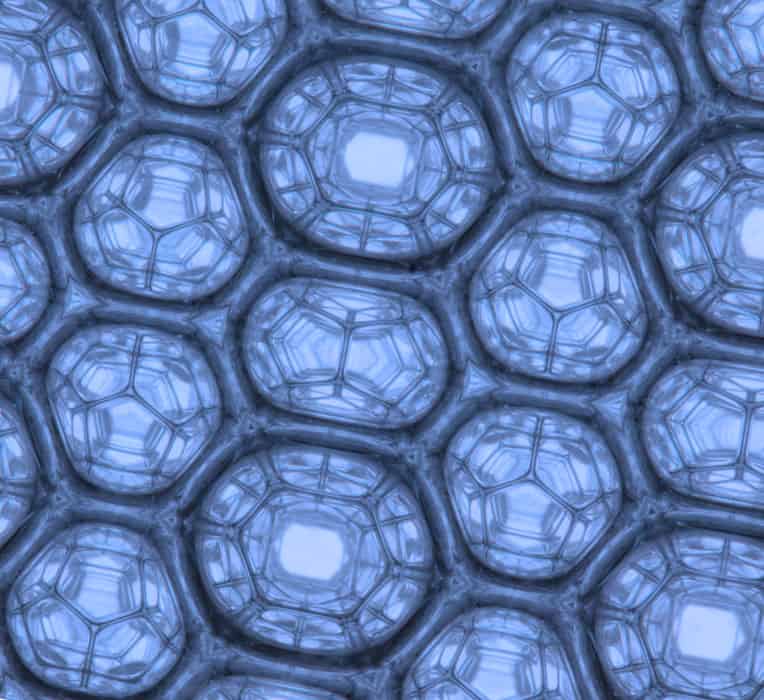
Pillar-shaped structures called scutoids have been spotted in a bubbly foam by physicists in Ireland and the UK. Their finding follows the discovery of scutoids in skin tissues in July 2018. The formation of scutoids in a simple foam suggests that physical processes are driving their creation, which could help with the development of artificially-grown tissues and organs.
Scutoids are column-like structures that are sandwiched between two surfaces. They have n sides at one surface and n-1 at the other. The name derives from their resemblance to a structure called a scutum, which appears in some insects.
Earlier this year, scientists in Spain and the US found scutoids between epithelial (skin) cells in curved tissues. It had been thought that scutoids were a biological phenomenon, but now physicists have shown that the emergence of structures can be understood using a relatively simple physical model.
Beer and sea foam
News of the scutoid discovery came to foam physicists Stefan Hutzler of Trinity College Dublin and Adil Mughal at Aberystwyth University just as they were both leaving for an annual scientific get-together in Northern Ireland.
“We meet once a year in a lovely cottage just by the sea and an adjacent pub,” says Hutzler. “After spending three days together thinking and discussing the occurrence of scutoids, while observing foam by the seashore and in pint glasses, we decided to perform simulations and experiments and look for scutoids in foam.”
“We got it cracked within a month,” he says, “including the simulations performed at Aberystwyth University and our experiments in Trinity”.
Dishwashing liquid
The team took a low-tech approach to creating scutoids by driving air from an aquarium pump into a solution made of dishwashing liquid to create evenly-sized bubbles. The bubbles were then placed between two concentric cylindrical surfaces to mimic the curved tissues in which biological scutoids were discovered.
They soon found scutoids, which the team believes formed as the bubbles sought to minimize their surface energies. This process has been recognized for more than a century as being the prime driver of foam cell formation.
To further understand this effect, physicists turned to computer simulations. These began with hexagonal cylindrical cells that were constrained by curved surfaces. Minimization of the surface energy of these cells resulted in the emergence of several stable scutoids.
Artificial organs
The usefulness of this simple foam model of scutoids must now be explored, but it could ultimately be used describe various biological systems and understand their behaviours. Indeed, knowing how scutoids emerge in complex biological tissues could lead to important insights into how artificial tissue or entire organs could be grown.
“We might get some indications what kind of cell structures could be formed during the growth of artificial organs,” says Hutzler. “We would only need the radii of the curvature and the cell size for the predictions.”

Getting to the froth of the matter
The team is now expanding the scope of the research and wants to identify the conditions and precise geometrical parameters required for scutoid formation. They also plan to study the biophysics and bioengineering aspects of scutoids.
Javier Buceta of Lehigh University, who was part of the team that discovered scutoids in skin tissue, said that his team was very excited about the Trinity-Aberystwyth study. “First, it revealed that our research was getting coverage and captured the interest of other groups working on different problems,” he told Physics World. “Secondly and more importantly, it proved that our idea about why nature decided to pack cells following this geometry was true: an energy minimization principle. In our case, we developed a biophysical model that was in agreement with experiments, but cells are way more complicated than foams and to build our model we discarded some energetic contributions under the assumption that tension was the most relevant one.”
Buceta adds, “As Hutzler and colleagues mention in their paper, this is a rough approximation and other terms can be relevant, but their experiments have shown that tension is indeed enough and that cellular packing can be explained invoking an energy minimization principle. Following these ideas, we are currently investigating more in detail these concepts of energy and forces in tissues and trying to link them with evolutionary principles.”
The study is described in Philosophical Magazine Letters.



